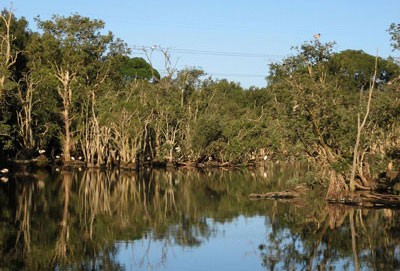The Independent Expert Scientific Committee on Unconventional Gas Development and Large Coal Mining Development (IESC) has developed a suite of resources to assist industry and regulators with environmental assessments. The resources provide guidance on the suggested information and data to be included in an environmental impact assessment. Providing appropriate information enables the IESC to provide robust scientific advice to government regulators on the potential water-related impacts of development proposals.
Most of the resources described here were developed before amendments to the Environment Protection and Biodiversity Conservation Act 1999 in December 2023 expanded the IESC’s remit to all types of unconventional gas development.

Reflections on the lake at the Hunter Wetlands Centre (Shortlands Wetland)
The Information Guidelines developed by the IESC, outline the information considered necessary to enable the IESC to provide robust scientific advice to government regulators on the water-related impacts of coal seam gas and large coal mining development proposals.
They were first published in March 2013, and are frequently reviewed to ensure that the most up-to-date scientific information is included. The Information Guidelines were updated in April 2014, October 2015, May 2018, and February 2024. The 2015, 2018 and 2024 updates included a public consultation processes which provided the opportunity for interested parties to make a submission on the draft update.
The 2024 update includes further information on numerical models as decision-support tools, the use of ecohydrological conceptual models which integrate hydrological and ecological components to show likely impact pathways and using metagenomic approaches such as environmental DNA to characterise ecological communities in surface waters and groundwaters. The updated version also has additional and clearer guidance on specific technical aspects and how the Information Guidelines align with the supporting Explanatory Notes.
The 2024 version builds on the risk-based approach of undertaking a risk assessment early in an environmental assessment process, which allows investigations of potential impacts and selection of management options commensurate with the project’s risk profile.
The checklist has been updated to help proponents address each aspect of assessing risk materiality. The checklist aims to ensure that all crucial environmental information is obtained and provided before a project proposal undergoes assessment.
Information Guidelines Explanatory Notes
For some topics, Explanatory Notes have been written to supplement the IESC Information Guidelines, providing tailored guidance and up-to-date robust scientific methodologies and tools for specific components of Environmental Impact Assessments. Case studies and practical examples of how to collect and present relevant information are also included.
The Explanatory Notes contain a greater level of detail about a specific topic than that provided in the Information Guidelines and improve clarity in expectations to reduce delays in the approval process. The topics for the Explanatory Notes have been chosen based on the IESC’s experience of providing advice on more than 160 development proposals.
Summary guides of each of the Explanatory Notes have been developed to provide a short, simplified outline of its key points.
Uncertainty analysis for groundwater modelling provides a range of approaches available to proponents and regulators in understanding and interpreting uncertainty analysis for groundwater modelling to assist in decision making.
Assessing groundwater-dependent ecosystems reviews tools and methods for groundwater-dependent ecosystem assessment to help proponents choose the most effective approach.
Deriving site-specific guideline values for physico-chemical parameters and toxicants introduces the use of a water and sediment quality management framework to assist with the design of appropriate monitoring programs for measuring physico-chemical parameters and toxicants from which site-specific guideline values can be developed.
Characterisation and modelling of geological fault zones provides a range of approaches available to proponents to determine, at the highest level, the role that faults may play in impeding or propagating pressure and groundwater flow impacts from proposed project developments.
Subsidence associated with underground coal mining provides tailored guidance and up-to-date robust scientific methodologies and tools for proponents to assess the risk and magnitude of subsidence due to large coal mining developments.
Subsidence associated with coal seam gas production provides tailored guidance and up-to-date robust scientific methodologies and tools for assessing the risk and magnitudes of subsidence (one source of surface movement) and its environmental impact due to coal seam gas development.
Using impact pathway diagrams based on ecohydrological conceptualisation in environmental impact assessment provides a methodology for mapping ecohydrological sources, pathways and receptors associated with potential impacts to water resources.
Explanatory Notes Virtual Masterclass Series
The IESC has hosted a series of virtual masterclasses, targeted at industry consultants, based on each of its Explanatory Notes. The masterclasses, presented by each note’s authors, provided the opportunity to describe how the methods in each Explanatory Note can be applied and to answer questions from participants.
Four masterclasses have been held and recordings can be viewed at the below links:
- 26 May 2021 – Uncertainty analysis–Guidance for groundwater modelling within a risk management framework
- 2 June 2021 – Assessing groundwater-dependent ecosystems
- 9 June 2021 – Deriving site-specific guideline values for physico-chemical parameters and toxicants
- 12 October 2022 – Characterisation and modelling of geological fault zones
Supplementary resources
The fact sheet – Environmental water tracers in environmental impact assessments for coal seam gas and large coal mining developments – provides case studies that explain how environmental water tracers can complement other types of information and investigations that are commonly undertaken for an environmental impact assessment.

